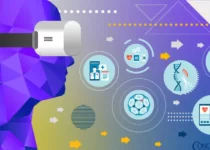Embracing the Future: A Deep Dive into Wearable Technology and Its Transformative Impact
Introduction:
Wearable technology, once confined to the realm of science fiction, has seamlessly integrated into our daily lives, becoming an integral part of the modern technological landscape. From smartwatches and fitness trackers to augmented reality glasses, wearables have evolved into powerful devices that extend beyond mere accessories, offering a myriad of functionalities. This article delves into the expansive world of wearable technology, exploring its history, diverse applications, technological innovations, societal impact, challenges, and the exciting possibilities it holds for the future.
A Brief History of Wearable Technology:
The roots of wearable technology can be traced back to the early attempts to merge computing capabilities with everyday accessories. The concept gained momentum in the 1960s and 1970s with the advent of early computing devices and experiments with incorporating them into wearable forms.
- Early Calculators and Pagers: The first wave of wearables included devices like early calculators and pagers that were integrated into wristwatches. These gadgets were precursors to the multifunctional smartwatches we know today.
- Digital Watches: The proliferation of digital watches in the 1980s marked a significant step forward. These watches not only displayed time but also incorporated additional features such as alarms, calculators, and basic data storage.
- Bluetooth Headsets: The early 2000s saw the emergence of Bluetooth headsets, allowing users to wirelessly connect to their mobile phones. This marked the beginning of wearables designed for seamless connectivity and hands-free communication.
- Fitness Trackers and Smartwatches: The breakthrough moment for wearable technology came with the introduction of fitness trackers and smartwatches in the 2010s. Fitbit, launched in 2008, popularized fitness tracking, while the release of the Apple Watch in 2015 catalyzed the smartwatch revolution.
- Augmented Reality (AR) Glasses: Augmented reality glasses, like Google Glass, entered the scene, offering users a hands-free display of information. While early iterations faced challenges, ongoing developments in AR technology continue to fuel interest in smart glasses.

Diverse Applications of Wearable Technology:
- Fitness and Health Monitoring: Fitness trackers and smartwatches have revolutionized personal health management. These wearables monitor metrics such as steps taken, heart rate, sleep patterns, and calories burned, providing users with real-time insights into their physical well-being.
- Medical Wearables: Wearables have extended their reach into the healthcare sector with medical-grade devices designed for monitoring chronic conditions, medication adherence, and even early detection of certain diseases. Continuous glucose monitors, ECG-enabled smartwatches, and smart inhalers exemplify this trend.
- Augmented Reality (AR) and Virtual Reality (VR): AR and VR wearables transport users to immersive digital environments. AR glasses overlay digital information onto the real world, enhancing experiences in fields like gaming, navigation, and professional training. VR headsets, on the other hand, offer fully immersive virtual experiences.
- Smart Clothing and Textiles: The integration of technology into clothing, known as smart textiles or e-textiles, has given rise to garments embedded with sensors and connectivity. These smart fabrics can monitor physiological parameters, track movements, and even change color or shape in response to stimuli.
- Navigation and Location Tracking: Wearables equipped with GPS technology facilitate navigation and location tracking. Smartwatches, fitness trackers, and even smart eyewear provide real-time location information, making them valuable tools for outdoor activities, navigation, and geotagging.
- Communication and Productivity: Bluetooth-enabled devices, such as smartwatches and earbuds, offer seamless communication and productivity features. Users can make calls, send messages, set reminders, and even access voice assistants directly from their wearables, reducing the need to interact with larger devices.
- Entertainment and Media Consumption: Wearables have become portable entertainment hubs. Smartwatches and AR glasses can stream music, display notifications, and even serve as remote controls for other devices. VR headsets immerse users in cinematic experiences, gaming, and virtual social environments.
- Payment and Access Control: Many wearables now support contactless payment options, enabling users to make transactions with a simple tap. Additionally, access control features allow wearables to serve as digital keys for secure entry into buildings, vehicles, or other restricted areas.

Technological Innovations in Wearable Technology:
- Advanced Sensors: The incorporation of advanced sensors, including accelerometers, gyroscopes, heart rate monitors, and environmental sensors, has enhanced the capabilities of wearables. These sensors enable precise data collection, making wearables powerful tools for health monitoring and activity tracking.
- Biometric Authentication: Wearables increasingly leverage biometric authentication methods, such as fingerprint sensors, facial recognition, and even electrocardiogram (ECG) readings, to enhance security and user verification.
- Flexible and Foldable Displays: Innovations in display technology have led to the development of flexible and foldable displays. Smartwatches and other wearables with curved or flexible screens offer improved aesthetics and functionality.
- Energy-Efficient Batteries: Addressing the challenge of limited battery life, wearables now feature energy-efficient batteries and improved power management. Advancements in battery technology, including the use of lithium-polymer cells and energy harvesting, contribute to longer usage times.
- Miniaturization and Lightweight Designs: Wearables continue to evolve with a focus on miniaturization and lightweight designs. Smaller form factors enhance user comfort and make wearables more discreet and aesthetically appealing.
- Integration of Artificial Intelligence (AI): AI algorithms are increasingly integrated into wearables to analyze data, personalize user experiences, and provide intelligent insights. AI enhances the predictive capabilities of wearables, enabling them to adapt to users’ preferences and behaviors.
- 5G Connectivity: The rollout of 5G networks has facilitated faster and more reliable connectivity for wearables. This advancement enables smoother data transmission, low-latency communication, and enhanced performance for wearables that rely on cloud services.
- Haptic Feedback and Gesture Control: Wearables now incorporate haptic feedback mechanisms and gesture control features. Haptic feedback provides tactile sensations, enhancing user interaction, while gesture control allows users to navigate interfaces through hand movements.

Societal Impact of Wearable Technology:
- Health and Wellness Revolution: Wearables have ushered in a health and wellness revolution, empowering individuals to take a proactive approach to their well-being. Fitness trackers encourage physical activity, smartwatches monitor vital signs, and medical wearables provide valuable health insights.
- Remote Patient Monitoring: The integration of wearables into healthcare facilitates remote patient monitoring, especially for individuals with chronic conditions. Physicians can receive real-time data, allowing for more proactive and personalized care.
- Improved Productivity and Efficiency: Wearables contribute to improved productivity by providing quick access to notifications, emails, and calendar events. Professionals can stay connected and organized without relying on larger devices, streamlining their workflows.
- Enhanced Safety and Security: Wearables contribute to enhanced safety and security through features like GPS tracking, emergency SOS functionalities, and biometric authentication. These features are particularly valuable in outdoor activities, travel, and emergency situations.
- Augmented Work Environments: AR glasses are poised to revolutionize work environments by overlaying digital information onto the real world. From hands-free navigation in warehouses to providing step-by-step instructions for complex tasks, AR wearables enhance efficiency and reduce errors.
- Social Connectivity: Wearables facilitate social connectivity by providing quick access to messages, calls, and social media updates. Smartwatches and earbuds enable users to stay connected without needing to constantly check their smartphones.
- Education and Training: In the realm of education and training, wearables offer immersive experiences. AR glasses can provide real-time information during educational sessions, and VR headsets can transport users to virtual classrooms or training simulations.

Challenges and Considerations in Wearable Technology:
- Privacy Concerns: The extensive collection of personal health and activity data by wearables raises privacy concerns. Users may be apprehensive about the security of their sensitive information and the potential misuse of data by third parties.
- Data Accuracy and Reliability: The accuracy and reliability of data collected by wearables, especially in health monitoring, remain areas of concern. Calibration issues, sensor limitations, and variations in user demographics can impact the precision of measurements.
- Limited Battery Life: Despite advancements in battery technology, many wearables still face challenges related to limited battery life. Users may find themselves needing to charge their devices frequently, impacting the convenience of continuous usage.
- Interoperability and Fragmentation: The diverse ecosystem of wearables from different manufacturers can result in interoperability challenges. Fragmentation in device compatibility and communication protocols may hinder seamless integration with other devices and platforms.
- Design and Aesthetic Considerations: Wearables often face design challenges in achieving a balance between functionality and aesthetics. Bulky or unappealing designs may deter users from adopting wearables as fashion accessories.
- Ethical Use of Wearables in Workplaces: The use of wearables in workplaces, especially those with tracking capabilities, raises ethical considerations related to employee privacy. Striking a balance between monitoring productivity and respecting individual privacy is crucial.
- User Adoption and Long-Term Engagement: Ensuring sustained user adoption and long-term engagement with wearables remains a challenge. Some users may lose interest or discontinue use if they perceive wearables as redundant or fail to see tangible benefits.
- Regulatory Compliance: The regulatory landscape for wearables is evolving, and compliance with data protection regulations, such as GDPR, is paramount. Manufacturers need to navigate complex regulatory frameworks to ensure the responsible and ethical use of wearables.

Future Directions in Wearable Technology:
- Health Monitoring Beyond Fitness: The future of wearables involves expanding health monitoring capabilities beyond fitness tracking. Wearables may evolve to monitor a broader range of health parameters, including blood pressure, glucose levels, and respiratory health, providing users with comprehensive insights into their well-being.
- Smart Fabrics and E-Textiles: Advances in smart fabrics and e-textiles may lead to wearables that seamlessly integrate into clothing. These garments could monitor health metrics, offer haptic feedback, and serve as unobtrusive yet powerful tools for health and fitness.
- Neurotechnology Wearables: Neurotechnology wearables may emerge to monitor and enhance cognitive functions. Devices capable of tracking brain activity, improving focus, and assisting in mental health management could become a reality.
- Wearable Robotics (Exoskeletons): Wearable robotics, particularly exoskeletons, may find widespread applications in healthcare, industry, and rehabilitation. Exoskeletons can assist individuals with mobility challenges and enhance physical capabilities in various settings.
- Expanded Use of Augmented Reality (AR): AR wearables are expected to become more prevalent, providing users with augmented information in real-time. From navigation to educational experiences, AR glasses may become commonplace tools for enhancing daily activities.
- Biometric Feedback for Mental Health: Wearables may incorporate biometric feedback to provide insights into mental health. Features such as stress level monitoring, mood analysis, and sleep pattern assessments could contribute to holistic well-being.
- Energy Harvesting and Extended Battery Life: Innovations in energy harvesting technologies may address the challenge of limited battery life. Wearables that harvest energy from ambient sources, such as body heat or motion, could lead to extended usage times and reduced reliance on traditional batteries.
- Wearables in Clinical Trials and Healthcare Research: Wearables are poised to play a crucial role in clinical trials and healthcare research. These devices can provide real-time, objective data for monitoring patient outcomes, medication adherence, and disease progression in a remote and continuous manner.

Conclusion:
Wearable technology has transcended its initial role as a mere accessory to become a transformative force in our lives. From monitoring our health and enhancing productivity to immersing us in augmented realities, wearables have become indispensable companions in the digital age. As technology continues to advance, wearables will likely evolve to offer even more sophisticated features, seamlessly integrating into our daily routines and empowering us to lead healthier, more connected, and efficient lives.
While wearables have brought about remarkable innovations, challenges such as privacy concerns, data accuracy, and ethical considerations must be carefully navigated. Striking a balance between technological advancements and ethical usage will be crucial in shaping the future of wearables. As we look ahead, the trajectory of wearable technology promises a future where these devices not only enhance our capabilities but also contribute to a more interconnected and technologically enriched society. Embracing the potential of wearables opens the door to a future where the boundaries between the digital and physical worlds blur, ushering in an era of seamless integration and unprecedented possibilities.
Related Posts

Devin AI: A Revolution or Reformation in Software Development?

Luminar AI: A Revolution in Photo Editing Powered by Artificial Intelligence

